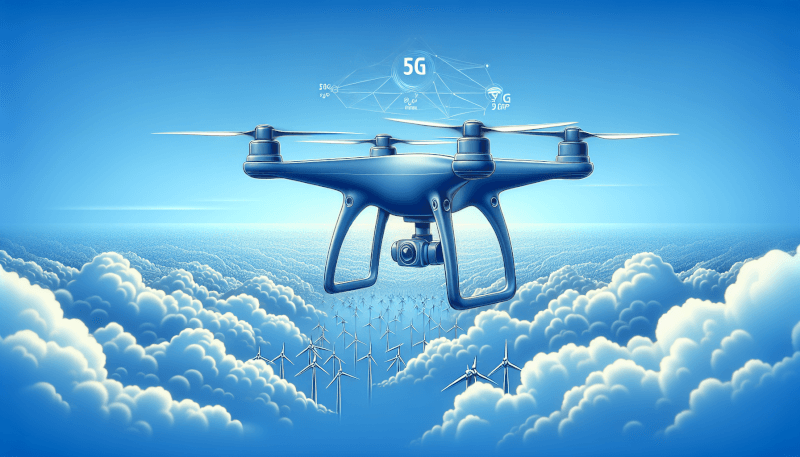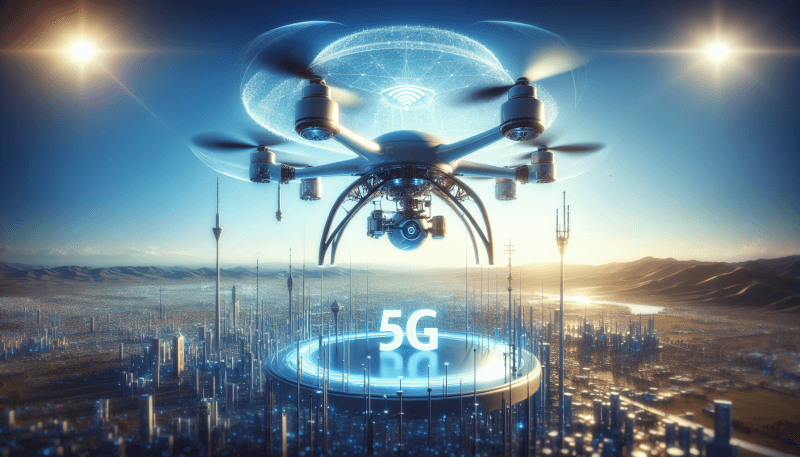Are you ready to explore the exciting realm of drone communication and how it is set to be revolutionized by 5G technology? In this article, we will delve into the remarkable impact that 5G is poised to have on drone communication. Get ready to discover how the faster speeds and lower latency of 5G will enhance the capabilities of drones, unlocking a whole new world of possibilities and applications. So, fasten your seatbelts and prepare for an exhilarating journey into the future of drone communication!

Improved Speed and Bandwidth
Enhanced data transfer
With the implementation of 5G technology, drones can experience significantly improved data transfer rates. The increased bandwidth allows for faster data transmission between the drone and the control station. This means that large amounts of data, such as high-resolution imagery or real-time surveillance footage, can be quickly and efficiently transmitted. As a result, operators can make more informed decisions and respond to situations in a timely manner.
Real-time communication
One of the most significant benefits of 5G technology for drone communication is the ability to establish real-time communication channels. Traditional communication methods, such as 4G networks, often suffer from latency issues, making it challenging for operators to maintain instant communication with their drones. However, with 5G, operators can enjoy seamless and lag-free real-time communication, enabling them to provide instructions, receive live video feeds, and monitor the drone’s status with minimal delay.
Faster data streaming
In addition to improved data transfer rates, 5G technology enables faster data streaming for drones. This means that drones can transmit video footage or sensor data in real-time without buffering or lag. The ability to stream data quickly and smoothly opens up new possibilities for applications such as live video broadcasting, remote inspections, and autonomous navigation. With 5G, drones can provide live feeds to operators, emergency responders, or relevant stakeholders, enabling them to make informed decisions based on real-time information.
Expanded Range and Coverage
Extended operating distances
With the implementation of 5G technology, drones can benefit from extended operating distances. Unlike previous generations of wireless communication, 5G offers a wider coverage range, allowing operators to control and monitor their drones from greater distances. This expanded range is particularly advantageous in scenarios where drones are used for long-range inspections, search and rescue missions, or monitoring large areas. 5G technology ensures that drones remain connected even in remote or difficult-to-reach locations.
Improved signal strength
One of the key advantages of 5G technology is its ability to provide improved signal strength for drone communication. This means that drones can maintain a strong and stable connection with the control station, even in challenging environments with obstacles or interference. The enhanced signal strength ensures reliable communication between the drone and the operator, reducing the risk of signal loss or disruption. As a result, operators can have increased confidence in their drone’s performance, especially in critical missions where a reliable connection is essential.
Expanded geographical coverage
5G technology offers expanded geographical coverage, which is instrumental for drone communication. This means that drones can operate in areas with limited or no previous network coverage, opening up new possibilities for industries such as agriculture, forestry, or infrastructure inspection. The expanded coverage eliminates the need for operators to rely on existing infrastructure or set up additional communication equipment in remote areas. Instead, drones can now access the network directly, allowing for efficient data transfer and seamless communication regardless of the geographical location.

Reduced Latency
Faster response times
One of the significant advantages of 5G technology for drone communication is the significantly reduced latency. Latency refers to the delay between the drone’s action and the operator’s command. With 5G, this delay is minimized to almost real-time, enabling extremely fast response times. This is particularly crucial in applications such as drone delivery or emergency response, where quick actions and immediate feedback are essential. With reduced latency, operators can control drones with precision and confidence, ensuring efficient and accurate execution of tasks.
Improved control and navigation
Low latency provided by 5G technology also enhances the control and navigation capabilities of drones. With minimal delay between the operator’s command and the drone’s response, drones can swiftly adjust their flight path, change directions, or avoid obstacles. This level of precision allows for more efficient and safer drone operations. Whether it’s inspecting critical infrastructure, mapping large areas, or monitoring hazards, improved control and navigation make drone missions more effective and reliable.
Reduced risk of accidents
The reduced latency offered by 5G technology not only improves response times and control but also contributes to reducing the risk of accidents. With faster communication between the drone and the control station, operators can quickly identify potential risks or hazards and take immediate action to avoid them. Whether it’s maneuvering around buildings, power lines, or other airborne obstacles, drones can make split-second decisions with reduced latency, effectively preventing collisions and accidents. Additionally, in emergency situations, drones can rapidly transmit critical information or initiate rescue operations without precious seconds lost due to communication delays.
Enhanced Connectivity
Seamless connection in crowded areas
One of the key advantages of 5G technology is its ability to provide seamless connectivity in crowded areas. Traditional communication networks often struggle to maintain reliable connections in densely populated areas or during events with high network traffic. However, 5G technology enables drones to establish and maintain a stable connection even in bustling environments. This is particularly beneficial for applications such as crowd monitoring, event management, or public safety, where drones rely on uninterrupted connectivity to provide real-time data and situational awareness.
Improved network reliability
5G technology significantly improves the reliability of drone communication by reducing the chances of signal loss or disruption. With more advanced signal processing algorithms and enhanced network infrastructure, operators can have greater confidence in their drone’s connectivity. This increased reliability ensures that drones can execute missions without the risk of losing crucial data or losing control of the aircraft. Industries such as construction, agriculture, or surveillance heavily rely on reliable communication, and 5G technology addresses these needs by minimizing the potential for connectivity issues.
Better signal penetration through obstacles
In many scenarios, obstacles such as buildings or terrain features can obstruct the wireless communication between drones and the control station. However, 5G technology offers superior signal penetration capabilities, allowing drones to establish connections even in challenging environments. The ability to penetrate obstacles ensures that drones can maintain communication and transmit data effectively, regardless of the physical barriers they encounter. This is particularly important for applications such as inspections, where drones need to access hard-to-reach areas or inspect structures with obstructed lines-of-sight.

Advanced Communication Features
Multi-drone collaboration
5G technology facilitates multi-drone collaboration, enabling multiple drones to communicate and coordinate their actions simultaneously. This communication capability opens up new possibilities for applications such as search and rescue missions, infrastructure inspections, or large-scale surveillance. With multi-drone collaboration, drones can work together efficiently, pooling their resources and sharing data in real-time. This results in improved efficiency, increased coverage, and enhanced situational awareness. By leveraging the power of 5G technology, operators can deploy a fleet of drones that operate seamlessly as a cohesive unit.
Swarm intelligence
Swarm intelligence is an emerging concept in drone technology, and 5G plays a crucial role in enabling it. Swarm intelligence refers to the ability of drones to work together in a decentralized manner, leveraging collective decision-making and cooperation. With 5G technology, drones in a swarm can communicate and share information rapidly, making split-second decisions collectively. This capability opens up new possibilities for applications such as disaster response, environmental monitoring, or precision agriculture. By harnessing the power of 5G, swarm intelligence allows drones to perform complex tasks, adapt to changing conditions, and achieve outcomes that would be challenging for individual drones to accomplish alone.
Automated communication protocols
Robust and automated communication protocols are essential for efficient and safe drone operations. 5G technology provides the foundation for the development of advanced communication protocols that enable seamless integration of drones into existing airspace systems. These protocols facilitate communication between drones, air traffic control, and other relevant stakeholders, ensuring safe and coordinated operations. With automated communication protocols, drones can transmit their flight plans, receive real-time airspace updates, and respond to dynamic changes in their environment. The integration of 5G technology with automated communication protocols paves the way for the widespread adoption of drones in various industries, while ensuring safety and compliance with existing regulations.
Increased Data Collection
Higher resolution imagery
As the adoption of 5G technology increases, drones can capture and transmit higher resolution imagery with unparalleled detail. With faster data transfer rates and increased bandwidth, drones equipped with high-quality cameras or sensors can transmit imagery in crystal-clear resolution. This advancement is particularly valuable in applications such as aerial mapping, surveying, or infrastructure inspections. High-resolution imagery allows operators to analyze data in greater detail, identify potential issues or anomalies, and make informed decisions based on accurate and up-to-date information.
Real-time analytics
5G technology enables drones to process and analyze data in real-time, thanks to its high-speed connectivity and low latency. Rather than relying on post-flight data analysis, operators can now benefit from real-time analytics, constantly receiving insights and actionable information while the drone is in operation. This real-time analysis is particularly useful in applications such as monitoring environmental conditions, spotting anomalies, or detecting potential hazards. With the ability to process data on the fly, drones can provide operators with instant feedback and alert them to any critical changes or situations that require immediate attention.
Efficient data transmission
Efficient data transmission is a crucial aspect of drone operations, as it impacts the overall performance and effectiveness of missions. 5G technology allows drones to transmit large amounts of data quickly and efficiently, without compromising the quality or integrity of the data. This is essential for industries such as agriculture, where drones capture vast amounts of field data that needs to be transmitted for analysis or processing. By leveraging the high-speed connectivity provided by 5G, drones can transmit data efficiently, reducing the time and resources required for data transfer and enabling more streamlined and efficient workflows.

Enhanced Safety and Security
Improved situational awareness
With enhanced connectivity and real-time data transmission, 5G technology significantly improves the situational awareness of both drones and operators. Drones can capture and transmit critical information, enabling operators to have a comprehensive understanding of the surroundings and make informed decisions. Real-time video feeds, sensor data, or live analytics provide operators with up-to-date situational awareness, allowing them to respond promptly to changing conditions or potential threats. This enhanced situational awareness is particularly important in applications such as disaster response, surveillance, or emergency management, where timely information can save lives and minimize risks.
Secure and encrypted communication
As drones become increasingly integrated into various industries, the importance of secure communication cannot be overlooked. 5G technology provides advanced encryption and security protocols, protecting the communication channel between the drone and the control station from unauthorized access or interference. This ensures that sensitive data, such as surveillance footage or confidential information, remains secure and protected. By leveraging the secure communication offered by 5G, operators can confidently deploy drones for applications that require privacy and data protection, such as corporate security, law enforcement, or critical infrastructure inspections.
Enhanced emergency response capabilities
The combination of 5G technology and drones revolutionizes emergency response capabilities, enabling faster and more efficient interventions. Drones equipped with advanced sensors, cameras, or thermal imaging capabilities can be rapidly deployed to assess emergency situations, gather critical data, and provide real-time information to emergency responders. With 5G’s low latency, drones can transmit data and receive instructions in real-time, ensuring that response teams have immediate access to the information they need to make informed decisions. This enhanced emergency response capability can significantly improve the effectiveness and efficiency of emergency operations, ultimately saving lives and reducing damage.
Integration with Internet of Things (IoT)
Seamless integration with IoT devices
The Internet of Things (IoT) is an interconnected network of devices that communicate and share data with one another. 5G technology seamlessly integrates drones with IoT devices, enabling them to collaborate and exchange information. This integration opens up new possibilities for applications such as smart cities, where drones can interact with various IoT devices to collect data, monitor infrastructure, or respond to environmental changes. For example, drones can connect with weather sensors, traffic cameras, or building management systems, creating a network of smart devices that work together to enhance efficiency and improve the overall quality of life.
Advanced data sharing and processing
By harnessing the power of 5G technology, drones can participate in advanced data sharing and processing within the IoT ecosystem. Drones can collect data from their surroundings, transmit it to the cloud or data centers, and leverage the computing power of these systems to process and analyze the data. This capability enables drones to perform complex analytics, derive actionable insights, or contribute to the development of AI algorithms. Advanced data sharing and processing allow drones to become integral components of the IoT infrastructure, bringing intelligence, automation, and efficiency to a wide range of industries.
Enabling smart city applications
The integration of 5G technology with drones and IoT devices paves the way for the development and implementation of smart city applications. Drones can contribute to various aspects of smart cities, from infrastructure monitoring and maintenance to public safety and environmental management. For example, drones can inspect bridges, monitor air quality, or provide real-time traffic updates. By leveraging the connectivity, speed, and advanced communication features of 5G, drones can become essential tools in building and managing sustainable, efficient, and livable cities of the future.

Impact on Industries
Agriculture
In the agricultural sector, 5G technology has the potential to transform traditional farming practices. Drones equipped with advanced sensors and cameras can monitor crop health, detect disease outbreaks, or optimize irrigation systems. With real-time data transmission and analysis, farmers can make data-driven decisions, such as adjusting fertilizer application or identifying areas that require immediate attention. The integration of 5G technology with drones provides a cost-effective and efficient solution for precision farming, resulting in increased yields, improved resource management, and reduced environmental impact.
Construction
The construction industry can benefit greatly from the capabilities offered by 5G technology for drone communication. Drones can be used for site inspections, project monitoring, or surveying land before construction begins. With 5G’s expanded range and coverage, drones can access remote or hazardous areas, capturing data that is crucial for project planning and execution. Real-time communication and high-resolution imagery enable construction teams to collaborate effectively, identify potential issues early on, and make informed decisions. By integrating 5G technology with drones, the construction industry can streamline processes, enhance safety, and improve overall project efficiency.
Logistics and delivery
The logistics and delivery industry is experiencing a significant shift with the introduction of drones and 5G technology. Drones can be used for last-mile delivery, providing faster and more efficient transportation of goods. With 5G’s seamless connectivity and enhanced safety features, drones can navigate complex urban environments, avoiding obstacles, and carrying out deliveries in a timely manner. Real-time communication and tracking capabilities ensure efficient coordination between drones and delivery operators, reducing the risk of delays or errors. The integration of 5G technology with drones opens up new possibilities for the logistics industry, offering a cost-effective and scalable solution for delivering packages in various environments.
Surveillance and security
The surveillance and security industry can harness the power of 5G technology to enhance its operational capabilities. Drones equipped with high-resolution cameras and advanced communication features can provide real-time video feeds, monitor large areas, or conduct aerial patrols. With 5G’s improved signal strength and expanded coverage, drones can operate in challenging environments, such as remote areas or densely populated urban spaces. Real-time communication and secure data transmission enable operators to receive instant updates, respond to potential threats, and ensure public safety. By leveraging 5G technology, the surveillance and security industry can achieve greater efficiency, effectiveness, and situational awareness, ultimately enhancing overall security measures.
Challenges for Implementation
Infrastructure requirements
The implementation of 5G technology for drone communication requires the development or enhancement of infrastructure capabilities. This includes the installation of 5G base stations, expansion of network coverage, and the establishment of a reliable communication infrastructure. These infrastructure requirements pose challenges in terms of cost, feasibility, and deployment. The necessary infrastructure must be in place to support seamless 5G connectivity, ensuring that drones can access the network without interruption, regardless of the geographical location.
Interference issues
Interference is a significant challenge when it comes to deploying 5G technology for drone communication. Other wireless devices, such as Wi-Fi routers or other mobile devices, can cause interference and disrupt the communication between drones and the control station. Interference can result in signal degradation, loss of connectivity, or reduced data transfer rates. To mitigate this challenge, it is crucial to address spectrum management and implement measures to minimize interference. The development of advanced signal processing algorithms and robust communication protocols also plays a role in overcoming interference issues.
Regulatory concerns
The integration of 5G technology and drones raises regulatory concerns that need to be addressed for widespread implementation. The use of drones in various industries, especially in urban environments or airspace shared with manned aircraft, requires compliance with existing regulations and standards. Regulatory bodies need to establish guidelines and safety protocols to ensure responsible drone operations and prevent potential risks. Additionally, privacy concerns and data protection regulations need to be considered to mitigate any potential misuse of the data collected by drones. Collaborative efforts between regulatory bodies, industry stakeholders, and technology providers are necessary to overcome these challenges and establish a framework that enables the safe and effective use of 5G technology for drone communication.
In summary, 5G technology has the potential to revolutionize the way drones communicate, opening up new possibilities, enhancing performance, and improving operational capabilities. Improved speed and bandwidth, expanded range and coverage, reduced latency, enhanced connectivity, advanced communication features, increased data collection, enhanced safety and security, integration with IoT, and impact on various industries are the key areas where 5G technology is driving significant advancements in drone communication. However, challenges related to infrastructure requirements, interference, and regulatory concerns must be addressed for the widespread implementation of 5G technology in the drone industry. As the technology continues to evolve and mature, the collaboration between industry, regulatory bodies, and technology providers will be crucial in unlocking the full potential of 5G for drone communication.


